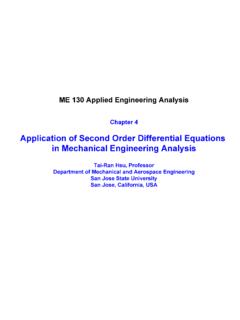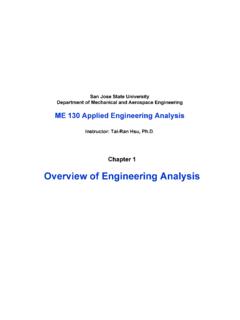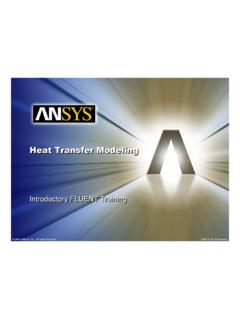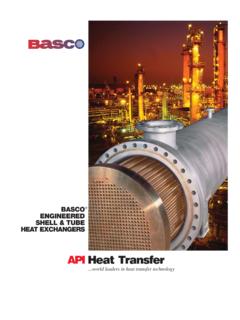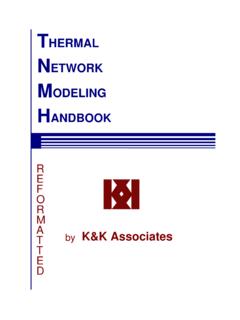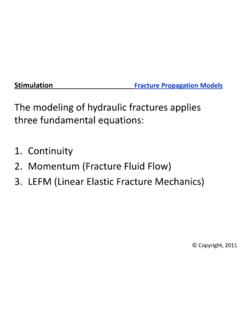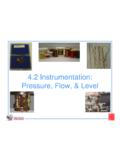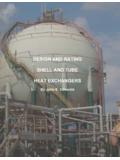Transcription of Application of First Order Differential Equations in ...
1 ME 130 Applied Engineering Analysis Chapter 3. Application of First Order Differential Equations in Mechanical Engineering Analysis Tai-Ran Hsu, Professor Department of Mechanical and Aerospace Engineering San Jose State University San Jose, California, USA. Chapter Outlines Review solution method of First Order ordinary Differential Equations Applications in fluid dynamics - Design of containers and funnels Applications in heat conduction analysis - Design of heat spreaders in microelectronics Applications in combined heat conduction and convection - Design of heating and cooling chambers Applications in rigid-body dynamic analysis Part 1. Review of Solution Methods for First Order Differential Equations In real-world, there are many physical quantities that can be represented by functions involving only one of the four variables , (x, y, z, t).
2 Equations involving highest Order derivatives of Order one = 1st Order Differential Equations Examples: Function (x)= the stress in a uni-axial stretched tapered metal rod (Fig. a), or Function v(x)=the velocity of fluid flowing a straight channel with varying cross-section (Fig. b): Fig. b Fig. a v(x). x (x). x Mathematical modeling using Differential Equations involving these functions are classified as First Order Differential Equations Solution Methods for First Order ODEs A. Solution of linear, homogeneous Equations ( ): Typical form of the equation: du ( x ). + p ( x) u ( x) = 0 ( ). dx The solution u(x) in Equation ( ) is: ( ). u (x ) =. K. F (x ). where K = constant to be determined by given condition, and the function F(x).
3 Has the form: F ( x) = e p ( x ) dx ( ). in which the function p(x) is given in the Differential equation in Equation ( ). B. Solution of linear, Non-homogeneous Equations (P. 50): Typical Differential equation: du ( x). + p ( x) u ( x) = g ( x) ( ). dx The appearance of function g(x) in Equation ( ) makes the DE non-homogeneous The solution of ODE in Equation ( ) is similar by a little more complex than that for the homogeneous equation in ( ): 1 K ( ). F ( x) . u ( x) = F ( x ) g ( x ) dx +. F ( x). Where function F(x) can be obtained from Equation ( ) as: F ( x) = e . p ( x ) dx Example Solve the following Differential equation (p. 49): (a). (Sin x )u ( x) = 0. du ( x). dx with condition u(0) = 2. Solution: By comparing terms in Equation (a) and ( ), we have: p(x) = -sin x and g(x) = 0.
4 Thus by using Equation ( ), we have the solution: u (x ) =. K. F (x ). F ( x ) = e p ( x ) dx = e Cos x , leading to the solution: in which the function F(x) is: u ( x ) = Ke Cos x Since the given condition is u(0) = 2, we have: 2 = K e Cos (0 ) = K e 1 =( ) K. e =. K. , or K = Hence the solution of Equation (a) is: u(x) = e-Cos x Example: solve the following Differential equation (p. 51): du ( x ). + 2u ( x) = 2 (a). dx with the condition: u(0) = 2 (b). Solution: By comparing the terms in Equation (a) and those in Equation ( ), we will have: p(x) = 2 and g(x) = 2, which leads to: F ( x) = e = e = e2x p ( x ) dx 2 dx By using the solution given in Equation ( ), we have: (e )(2)dx +. 1 K 1 K K. F ( x) . u ( x) = F ( x ) g ( x ) dx + = 2x = 1 +.
5 F ( x) e 2 x e2x e2x We will use the condition given in (b) to determine the constant K: u ( x ) x =0 = 2 = 1 +. K. = 1+ K K = 1. e2 x x =0. Hence, the solution of Equation (a) with the condition in (b) is: 1 2 x u ( x) = 1 + = 1 + e e2x Part 2. Application of First Order Differential Equation to Fluid Mechanics Analysis Fundamental Principles of Fluid Mechanics Analysis Fluids - A substance with mass but no shape Compressible Non-compressible (Gases) (Liquids). Moving of a fluid requires: A conduit, , tubes, pipes, channels Driving pressure, or by gravitation, , difference in head . Fluid flows with a velocity v from higher pressure (or elevation) to lower pressure (or elevation). The law of continuity -Derived from Law of conservation of mass -Relates the flow velocity (v) and the cross-sectional area (A).
6 A1. A2. The rate of volumetric flow follows the rule: v1 v2 q = A1v1 = A2v2 m3/s A1 A2. Terminologies in Fluid Mechanics Analysis Higher pressure (or elevation). Fluid velocity, v Cross-sectional Area, A. Fluid flow The total mass flow, Q = A v t (g ) ( ). Q ( ). Total mass flow rate, Q& = = Av (g / sec). t & Q&. Total volumetric flow rate, V = = Av (m 3 / sec) ( ).. Total volumetric flow, V = V& t = A v t (m 3 ) ( ). in which = mass density of fluid (g/m3), A = Cross-sectional area (m2), v = Velocity (m/s), and t = duration of flow (s). The units associated with the above quantities are (g) for grams, (m) for meters and (sec) for seconds. In case the velocity varies with time, , v = v(t): Then the change of volumetric flow becomes: V = A v(t) t, ( ).
7 With t = time duration for the fluid flow The Bernoullis Equation (The mathematical expression of the law of physics relating the driving pressure and velocity in a moving non-compressible fluid). (State 1) (State 2). v2. ity, Pressure, p2 l oc Ve ath Pressure, p1 Flow P. Velocity, v1 Elevation, y2. Elevation, y1. Reference plane Using the Law of conservation of energy, or the First Law of Thermodynamics, for the energies of the fluid at State 1 and State 2, we can derive the following expression relating driving pressure (p) and the resultant velocity of the flow (v): v12 p1 v 22 p The Bernoullis Equation: + + y1 = + 2 + y2 ( ). 2g g 2g g Application of Bernoullis equation in liquid (water) flow in a LARGE reservoir: Fluid level State 1.
8 Head, h Elevation, y1. v1, p1. Water tank Large Reservoir Tap exit v2, p2 State 2. y2 Tap exit Reference plane From the Bernoullis's equation, we have: v12 v 22 p p2. + 1 + ( y1 y 2 ) = 0 ( ). 2g g If the difference of elevations between State 1 and 2 is not too large, we can have: p1 p2. Also, because it is a LARGE reservoir (or tank), we realize that v1 << v2, or v1 0. v 22. Equation ( ) can be reduced to the form: +0+h = 0 with h = y1 y 2. 2g from which, we may express the exit velocity of the liquid at the tap to be: v2 = 2 gh ( ). Application of 1st Order DE in Drainage of a Water Tank D. ho ho h(t) H2O. Velocity, v(t). d ,A. ea ar Initial water level = ho al Tap Exit i on Water level at time, t = h(t). ct se X- Use the law of conservation of mass: The total volume of water leaving the tank during t ( Vexit) =.
9 The total volume of water supplied by the tank during t ( Vtank). We have from Equation ( ): V = A v(t) t, in which v(t) is the velocity of moving fluid Thus, the volume of water leaving the tap exit is: d 2 (a). Vexit = A v(t ) t = 2 g h(t ) t 4 . with v(t ) = 2 g h(t ) Given in Equation ( ). Next, we need to formulate the water supplied by the tank, Vtank: D. The initial water level in the tank is ho h(t) The water level keeps dropping after the tap exit is opened, and the reduction of ho Water level is CONTINUOUS. h(t) H2O. d Let the water level at time t be h(t). Velocity, v(t). We let h(t) = amount of drop of water level during time increment t D 2. Then, the volume of water LOSS in the tank is: Vtan k = h(t ) (b).
10 4. (Caution: a - sign is given to Vtank b/c of the LOSS of water volume during t). The total volume of water leaving the tank during t ( Vexit) in Equation (a) =. The total volume of water supplied by the tank during t ( Vtank) in Equation (b): Equation (a): Equation (b): d 2. D 2. 2 g h(t ) t = h(t ) (c). 4 4. h(t ) 1/ 2 d . 2. By re-arranging the above: = [h(t )] 2 2 g (d). t D . If the process of draining is indeed CONTINUOUS, , t 0, we will have Equation (d) expressed in the Differential rather than difference form as follows: dh(t ) d2 ( ). = 2 g 2 h(t ). dt D . with an initial condition of h(0) = ho (f). Equation ( ) is the 1st Order Differential equation for the draining of a water tank. The solution of Equation ( ) can be done by separating the function h(t) and the variable t by re-arranging the terms in the following way: dh(t ) d2.
